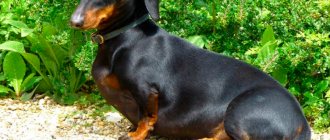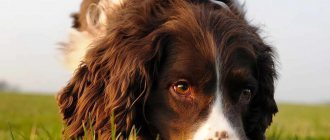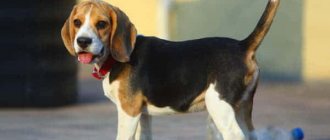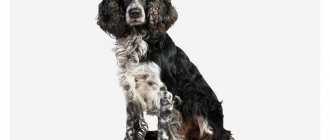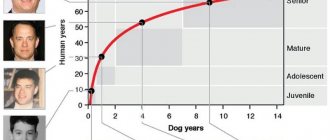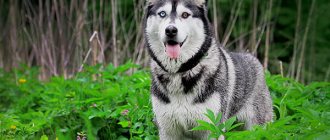Becoming the happy owner of a cheerful and active dachshund puppy, his owner must already realize that the pet will someday begin to grow old, and then the time will come to part with him.
Fortunately, Dachshunds are in good health and, if properly cared for, can live quite a long time.
But what can a dachshund owner do to ensure that his dog lives as long as possible?
And how to care for an elderly pet to extend its days as much as possible?
Weight and height of a dachshund - how much should it weigh by month, sizes of a puppy and an adult dog
The breed was specially bred for burrow hunting, which becomes more exciting thanks to the courage, intelligence and activity of the dogs. Adult animals are prone to obesity, so their diet is monitored especially carefully. Excess weight in a Dachshund can cause health problems, loss of physical activity and a shortened life expectancy.
How long do dwarf and rabbit dogs live?
The life expectancy of a dwarf dachshund , on average, is 12-14 years .
Rabbit dachshunds live about the same: their average lifespan is 13 years.
How old do dachshunds grow?
Before growing to the standard, the dachshund goes through several stages of development:
- intrauterine – from mating to birth of the puppy;
- suckling – from birth to the end of breastfeeding;
- childhood and adolescence – from 6 weeks to 0.5 years;
- youth – from 0.5 to 1.5 years;
- adult dog - after 1.5 years.
Estrus in females and puberty in males occurs by the age of one year, but this does not mean that they are ready for mating. For breeding, the most suitable age is 2 years. At one and a half years, taxi drivers have a fully formed skeletal and muscular system, so height and weight measurements are carried out during this period.
Why know a dog's age?
All veterinarians and shelter staff know how to determine the age of a dog. Determining the number of years is necessary for:
- scheduling vaccinations;
- preparation for sterilization or castration;
- safe and effective mating;
- choosing the right diet and intensity of walking.
The estimated date of birth is recorded in the dog's passport. After reaching 8 years of age, your pet’s health should be checked every six months so as not to miss the development of internal pathologies.
How to measure a dachshund?
To measure a dog’s height at the withers at home, proceed according to the following scheme:
- They bring the baby dachshund to the door frame.
- They place it so that the dog does not bulge its back and does not sit on its hind legs.
- Make a notch with a pencil at the level of the upper part of the withers.
- Measurements are taken three times.
- Measure the distance using a metal ruler.
They weigh it using a steelyard, after placing the dog in the bag. In most cases, a dachshund weighs less than 15 kg, so you can pick it up and stand on a bathroom scale. The difference between the obtained and your own indicators will give the weight of the pet.
All measurements should be taken after one and a half years. Normally, standard smooth-haired and long-haired varieties do not look frail or bulky. They have a harmonious build, well-developed muscles, short legs and a chest wider than the waist.
A year in seven
Unfortunately, our beloved zoo friends live much shorter than us. It has always been believed that in order to convert a dog’s age to a human’s, you need to multiply it by 7, that is, one year of a dog’s life is equal to seven years of a person’s life. However, this is not quite true. After all, a one-year-old dog can become a parent, but a seven-year-old child cannot. Also, an 11-year-old dog is much more active than a 77-year-old man.
Therefore, a new method of calculation was established. Now the question of how to calculate the age of a dog is answered as follows:
- a one-year-old dog is equivalent to a fifteen-year-old teenager;
at two years old, a dog is equivalent to a 24-year-old person;
After two years, each year of a dog's life is equal to four human years.
Dachshund puppy weight by month
The weight of taxis depends on gender, age, individual characteristics, physical activity, appetite and diet. The table below shows the weight of the dachshund by month. The values are average; the indicators of a particular dachshund may differ, since each puppy develops according to an individual pattern.
| Age | Weight (in g) | ||
| Standard | Dwarf | Rabbit | |
| At 1 month | 1200-1900 | 650-1180 | 380-450 |
| At 2 months | 2050—2750 | 1470-1920 | 770-1000 |
| At 3 months | 2830-3850 | 1880-2530 | 950-1260 |
| At 4 months | 4100-5360 | 2960-3320 | 1350-1840 |
| At 5 months | 5210-7100 | 3220-3850 | 1420-2080 |
| At 6 months | 7250-8540 | 3440-4060 | 1600-2240 |
| At 7 months | 7320-8720 | 3430-4,48 | 1800-2450 |
| At 8 months | 7550-8820 | 3,62-4650 | 2120-2600 |
| At 9 months | 7640-8850 | 3810-5040 | 2300-2800 |
| At 10 months | 7720-9030 | 3900-5150 | 2450-2850 |
| At 11 months | 8150-9140 | 4050-5320 | 2540-2920 |
| At 12 months | 8500-9100 | 4000-5500 | 2550-3000 |
Puppy teeth
Dogs are born without teeth. On the 20th day of life, the first of them begin to emerge: fangs and hooks. By the age of one and a half months, the puppy should have a full set of baby teeth.
At the age of 3-6 months they gradually change to permanent ones. The first to fall out are the incisors, then (at 3-5 months) the premolars, middle incisors and edges. At six months of age, it is time for fangs. This pattern of teeth changing is the best answer to the question of how to tell the age of a dog whose baby teeth are falling out.
A one-year-old dog already has a full set of teeth. They are snow-white, with characteristic tubercles.
The change process may occur with slight deviations from the generally accepted schedule, but in general, the age at which dogs grow is the age at which their teeth change.
Puppy growth by months
The physical development of dachshunds is completed at one and a half years. At this age, control measurements of the height of the dachshund at the withers are taken. Do not worry if the readings differ from those indicated in the table by 15-20%, the puppies can grow evenly or spasmodically.
| Age (months) | Height (in mm) | |||||
| Standard | Dwarf | Rabbit | ||||
| Boys | Girls | Boys | Girls | Boys | Girls | |
| 1 | 104-118 | 91-101 | 81-92 | 70-82 | 72-81 | 64-74 |
| 2-3 | 152-164 | 142-154 | 122-130 | 111-122 | 82-100 | 75-93 |
| 4-5 | 183-192 | 170-181 | 124-141 | 115-130 | 94-105 | 92-101 |
| 6 | 201-206 | 191-202 | 152-171 | 142-164 | 112-123 | 94-110 |
| 7-8 | 207-218 | 193-204 | 153-182 | 143-171 | 114-135 | 101-112 |
| 9-10 | 220-251 | 196-230 | 160-201 | 144-186 | 115-141 | 102-120 |
| 11-12 | 222-264 | 198-250 | 164-212 | 145-190 | 121-150 | 103-130 |
| 15-18 | 224-272 | 204-250 | 165-215 | 155-190 | 122-10 | 104-130 |
The shape of the taxi is rectangular. According to the standard for all varieties, the ratio of height to length of a dachshund in cm is 1:1.7. The body elongation index is 170-180%.
Dachshund sizes by age
The average weight of an adult standard size dog is 8-9 kg. It depends on the type of dachshund, its gender and age. So, the normal weight of a miniature rabbit dachshund is 2.5-3.5 kg.
| Age | Standard | Dwarf | Rabbit | |||||||||
| Boys | Girls | Boys | Girls | Boys | Girls | |||||||
| weight, g | height, mm | weight, g | height, mm | weight, g | height, mm | weight, g | height, mm | weight, g | height, mm | weight, g | height, mm | |
| At 1 year | 8520-9100 | 220-270 | 7500-8800 | 200-250 | 4000-5500 | 160-210 | 3500-4800 | 152-190 | 2500-3000 | 110-141 | 2000-2410 | 100-132 |
| At 2 years old | 8610-9150 | 230-270 | 7550-8900 | 210-255 | 4000-5600 | 174-210 | 3600-4910 | 161-192 | 2610-3050 | 122-150 | 2100-2510 | 112-144 |
| At 3 years old | 8620-9170 | 240-270 | 7560-8810 | 220-256 | 4100-5600 | 181-211 | 3610-4920 | 172-194 | 2610-3100 | 131-151 | 2150-2580 | 120-145 |
| At 4 years old | 8640-9190 | 240-270 | 7560-8810 | 225-257 | 4100-5610 | 192-212 | 3620 -4920 | 178-198 | 2650-3150 | 132-152 | 2200-2600 | 122-146 |
| At 5 years old | 8650-9210 | 250-270 | 7560-8820 | 226-257 | 4100-5610 | 193-213 | 3680-4920 | 178-199 | 2650-3250 | 140-152 | 2210-2600 | 140-151 |
| At 6 years old | 8660-9220 | 240-270 | 7560-8830 | 230-257 | 4200-5610 | 193-214 | 3700-4920 | 178-200 | 2650-3300 | 140-153 | 2250-2610 | 141-151 |
| At 7 years old | 8660-9225 | 245-272 | 7560-8850 | 231-257 | 4200-5620 | 197-216 | 3700-4900 | 179-200 | 2680-3300 | 141-154 | 2280-2610 | 141-152 |
| 8-10 years | 8660-9240 | 246-272 | 7600-8800 | 235-258 | 4300-5680 | 200-220 | 3700-4900 | 179-201 | 2690-3350 | 142-158 | 2380-2640 | 141-152 |
| 11-13 years old | 8665-9260 | 246-275 | 7600-8800 | 236-258 | 4300-5700 | 202-220 | 3700-4900 | 180-201 | 2700-3400 | 143-160 | 2400-2650 | 142-152 |
| 14-16 years old | 8660-9300 | 246-275 | 7,4-8800 | 244-259 | 4400-5800 | 208-220 | 3700-4900 | 181-200 | 2700-3400 | 15-16 | 2400-2700 | 141-151 |
Main causes of premature death
Dachshunds can be predisposed to a number of diseases:
- Chest deformity.
- Slipped disc syndrome leading to paralysis.
- Epilepsy.
- Progressive retinal atrophy.
- Anomalies of eye development.
Most of them do not lead to the death of the dog . But due to the fact that the dachshund loses the ability to move, see, or due to more frequent seizures, in some cases, owners have to euthanize the pet to save it from suffering.
In older dachshunds, a chronic disease that had previously occurred in a latent form may suddenly worsen, which is also often the reason that a pet that could have lived for quite a long time suddenly dies at the age of 8-10 years.
Accidents or injuries are also a common cause of premature death in dachshunds..
Moreover, often this happens because the owner himself caused an accident due to inattention. And deliberate disregard for safety almost always leads to tragic consequences for the pet.
This happens, for example, when the owner, wanting to show off the dog’s excellent training, takes it for a walk on a street without a leash where there are a lot of cars.
CAREFULLY!
Many dogs die due to poisoning, such as from eating a poisoned rodent or licking a surface treated with a chemical.
Therefore, you need to be careful when using pesticides in everyday life: do not throw them where the pet can get them, and while the surfaces are being treated, the dog must be removed from the room.
Poisoning rodents if you have a dachshund in the house is not recommended: it is better to try to get rid of mice or rats in another way that is safe for your pet..
What to do if your dachshund's weight is below normal
If a person's height, weight, or size lags behind schedule by more than 20%, this is a cause for concern. In this case, you need to contact a veterinarian and have your pet examined. In the absence of pathologies, the taxi driver’s diet is revised to increase the proportion of protein products, vitamin and mineral supplements, raw and boiled vegetables and fruits are introduced. You should take them for walks in the fresh air more often and regularly give them anthelmintics.
Proper nutrition
In order for a dachshund to live a long time, it must eat properly. Dogs of this breed can be fed home-cooked food, and the share of meat and meat products in its daily diet should be at least 30%.
For working dogs, this rate is recommended to be increased to 50%..
It is necessary to add porridge from rice, buckwheat or oatmeal (rolled oats) to the meat. Vegetables should also be included in your pet's diet.
From time to time you can treat your dachshund with fruits, such as apples or bananas, as well as a piece of low-fat hard cheese . But you need to remember that these products are a delicacy and their share in the diet should be insignificant.
Feeding ready-made premium, super-premium or holistic food is also allowed, and the food must correspond to the size and age of the animal.
How old do dachshund puppies grow?
Before a baby dachshund becomes an adult, it goes through several stages in its development:
- intrauterine – from fertilization to birth;
- neonatal or newborn – the first two weeks after birth;
- suckling – before the transition from breast milk to adult feeding;
- childhood - from one and a half to three months;
- adolescence - from four months to six months;
- youth – from 6 months to 1.5 years;
- adult dog - from one and a half years.
Puberty occurs from eight months to a year, but breeding dachshunds at this time is not recommended, since they have not yet fully formed, either physically or psychologically. Their growth stops, but the physiological development of the dachshund puppy and the gain of muscle mass continue. They are considered adults starting from 15-18 months.
How to extend the life of a pet?
To extend your dachshund's life, you need to take proper care of it from the first day the puppy arrives in your home.
Good maintenance and care, a balanced diet, adherence to a schedule of vaccinations , deworming and treatment for external parasites - this is the guarantee that a dachshund puppy will grow into a healthy adult dog and live a long time .
It is absolutely necessary to teach a pet of this breed at least basic commands: this will help minimize the risk of accidents while walking with your pet.
But teaching commands alone is not enough: the dachshund needs to be educated, and this process must continue throughout the dog’s life. For example, you need to wean your dog from running after moving vehicles, rushing at other dogs, or picking up all sorts of nasty things from the ground.
After all, all this often causes injury or poisoning, and fights with stray dogs, in addition, are fraught with the risk that the pet will contract rabies or, for example, distemper.
If a dachshund takes part in breeding , then you need to be responsible for its use as a sire, and provide quality care during estrus .
Too frequent matings are harmful for dogs of both sexes; they exhaust their bodies and can significantly shorten their lives.
When can you wean from your mother?
The longer dachshunds are breastfed, the faster they develop and grow. It is known that cubs double their weight just a week after birth if they are fed by their mother. On artificial food they achieve such weight gain in two weeks.
Breast milk contains all the beneficial microelements, proteins, fats, vitamins and substances that form passive immunity, protecting puppies from infections for up to 2-4 months. They begin to wean from the mother in the fifth week of life, doing this gradually - first the strongest, then the rest. During this period, babies' baby teeth are already growing, so solid food becomes quite accessible. The amount of milk in the mother decreases, it is alternated with new food and after 10-20 days the transition to normal nutrition is completed.
How to find out a dog's age
If the puppy was purchased from a nursery or from private breeders, the exact date of its birth is known. It is indicated in the accompanying documents, or the previous owner communicates it to the new owner in a conversation. But it happens that a faithful and kind dog was found on the street, and then the owner simply needs to figure out how to find out the dog’s age.
It can be determined by the condition of the animal’s fur, eyes or muscle tone. But the most accurate method of determination is by the condition of the teeth. In dogs, they change only once in their life, so the degree of their wear and tear will clearly indicate the number of years the animal has lived.
What dachshund puppies look and behave like (by age)
Before purchasing a dachshund, you need to know how he will grow up and how he develops from a newborn kitten to an adult beautiful dog. The correct actions of the owner determine the normal weight gain of the pet, the state of its health, and the acquisition of the necessary skills during upbringing and training.
Newborn puppies
A dachshund cub is born quite large - weighing 200-300 g (up to 7% of the mother’s body weight). Healthy puppies feel warm and dry to the touch, but they cannot regulate their body temperature, so they need to be kept warm. Newborn babies are blind and deaf and are able to react to cold, pain and touch. The first 7 days they sleep and suckle. On the fourth day they recognize the mother’s smell and find her nipples themselves, on the fifth day their nose becomes colored, on the eighth day their weight doubles.
Routine veterinarian visit, vaccinations
You need to visit a veterinarian regularly, especially if your dog has chronic diseases. All emerging diseases must be treated on time and not delayed. It is also important to carry out all necessary vaccinations in a timely manner, which will help protect your pet’s body from diseases such as:
- plague,
- parainfluenza,
- leptospirosis,
- hepatitis,
- rabies,
- enteritis.
Note! It is also necessary to treat your pet for worms and other parasites. For this purpose, medications are used that protect the dog from fleas, lice and ticks. Harmful insects are often carriers of quite serious diseases that can cause the premature death of a pet.
Care and maintenance of dachshunds
Caring for taxis consists of creating comfortable living conditions for them, proper feeding, timely vaccination and deworming. An active dog needs regular walks and feasible physical activity. Education and training should be carried out by one person, in whom the pet sees the leader, leader and owner.
Ear and eye care
Dachshund ears are very sensitive and delicate. In order not to injure weak cartilage, you need to act carefully. The ears are wiped weekly with cotton pads soaked in boiled warm water or hydrogen peroxide. If there is an odor or discharge from the ears, contact a veterinarian.
The dog's eyes are examined daily and wiped with a disc dipped in chamomile infusion. If there is excessive lacrimation, conjunctivitis or allergies are suspected, treatment begins after visiting a veterinary clinic.
Paw and coat care
After each walk, the taxi driver’s paws are inspected to see if he has picked up a splinter or injured his pad. Wash them thoroughly with soap and dry with a towel. Overgrown claws are shortened using special nippers and treated with a nail file.
Wool does not require special care. Short-haired dachshunds are brushed during the molting period, while long-haired ones are brushed daily.
Baby teeth and cleaning them
At three weeks of age, taxi dogs begin to develop their first baby teeth. They are more fragile and sharp than permanent ones. They begin to get used to brushing at two months. To do this, wrap a bandage around your finger, apply a special paste to it, and clean the outside of your teeth. After the puppy gets used to it, they begin to use the brush.
How to prepare for the arrival of a baby dachshund in the house
Before bringing a small taxi into the house, the following preparations are carried out:
- Remove wires and unstable objects from the floor.
- They tolerate poisonous houseplants that puppies can reach.
- They hide medicines and household chemicals in a place inaccessible to them.
- Carry out general cleaning.
- Determine a place for resting, toileting and feeding the pet.
- They buy everything they need.
Caring for an older dog
An older dachshund needs the attention and care of its owner more than in its younger years. Many dogs already have difficulty seeing and hearing, and therefore they should only be taken for walks on a leash.
In addition, it is necessary to carefully protect an elderly pet from drafts, and in cold weather, dress him in a blanket, sweater or overalls, even if he previously managed well without clothes.
In general, caring for an older dog remains the same and includes brushing, cleaning eyes, ears and teeth, as well as trimming nails..
But you should not bathe an older dog unless necessary: there is a very high risk that it will catch a cold.
IMPORTANT!
It is recommended to take your elderly pet to the veterinary clinic for preventive examinations at least once a year.
With good living conditions and quality care, dachshunds can live much longer than most other dog breeds - up to 17 years or more.
You also need to understand that poor quality nutrition or improper living conditions for a pet lead to many diseases that significantly shorten its life.
But even if the dog is provided with the best of all possible conditions, we must not forget that a dachshund, living in a family, should feel love and care from its owners from the first day of its arrival in the house until the last minutes of its life.
And that it is the attentive and responsible attitude of the owner towards the pet that is the main factor that allows the dachshund to live long and happily.
The difference between a boy and a girl, how to choose
To distinguish a girl dachshund from a boy, you need to take a one-month-old puppy in your arms and examine its belly. The female has a navel and nipples; the male also has a genital organ. It must be remembered that this is difficult to do in a newborn baby, since the genital organ is poorly expressed.
When choosing a puppy, follow several recommendations:
- The eyes of a healthy taxi are clear, most often brown.
- Scissor bite.
- There is a brand on the stomach or right ear.
- The tail is without kinks.
- Gums and tongue are pink.
- The nose and claws are black or brown.
- The black color has tan.
- The puppy is not fat, but well-fed.
- He behaves confidently and is not afraid of any noise.
